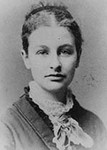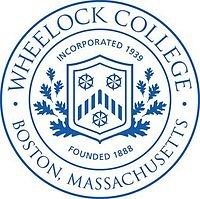Wheelock College (1888–2018)
Introduction
Text-to-speech Audio
Images
Lucy Wheelock

Official Wheelock Seal

Backstory and Context
Text-to-speech Audio
Born in Vermont in 1857, Lucy Wheelock always had a desire for education. She moved to Reading, Massachusetts at age 15 and attended high school there. Wheelock was determined to get to college and applied to the newly coeducational Chauncy Hall School in Boston after her graduation in 1874. There she hoped to prepare herself to apply to Wellesley College. However, she never applied to any college and instead found a passion for early childhood education after visiting a kindergarten.
Lucy Wheelock enrolled in Mrs. Ella Snelling Hatch’s Kindergarten Training School to pursue her newly found passion in 1878. She learned from Elizabeth Palmer Peabody who is considered the founder of the kindergarten movement in America. A year later, she graduated from the school and returned back to Chauncy Hall to teach kindergarten. She followed Friedrich Fröbel’s methods but was not afraid to deviate from it when she saw it necessary. This gained her attention though it was not all positive. Some conversative kindergarteners called her a heretic and thought she was being too controversial. Her methods would eventually pay off as she was asked to teach a training class at Chauncy Hall when public kindergartens were permanently instituted in Boston.
Wheelock’s class was so successful that by 1896, she was able to open up her own school known as the Wheelock Kindergarten Training School. She also was active in the national kindergarten movement. Wheelock became a leading voice within the International Kindergarten Union and served as its president from 1895 to 1899. Wheelock later chaired the IKU’s Committee of Nineteen. Their goal was to bridge the gap between the conservative and liberal members of the kindergarten community but they were unable to achieve this. Along with the IKU, Wheelock was involved with the National Congress of Mothers and even was appointed to the education committee of the League of Nations in 1929.
Even as an active member of the kindergarten movement, Wheelock still served as director of her school until 1939. By that time, Wheelock School had expanded its curriculum to include primary and nursery courses while also integrating aspects of the arts and sciences into classes. A permanent campus was even established in Boston’s Fenway neighborhood in 1914. Wheelock School had approximately 350 students by the time Lucy Wheelock retired. Two years later, it officially became Wheelock College.Lucy Wheelock died in Boston in 1946. She was an influential member of the kindergarten movement in American and a champion of early childhood education. Her dedication and passion was and still is inspiring to many. Despite her critics, Wheelock remained heavily involved in education until late in her life. Her legacy lives on with her school which is now fully incorporated into Boston University as the Wheelock College of Education and Human Development.
Cite This Entry
Emily Scrementi and Clio Admin. "Wheelock College (1888–2018)." Clio: Your Guide to History. October 6, 2018. Accessed April 12, 2025. https://theclio.com/tour/658/3/reverse

